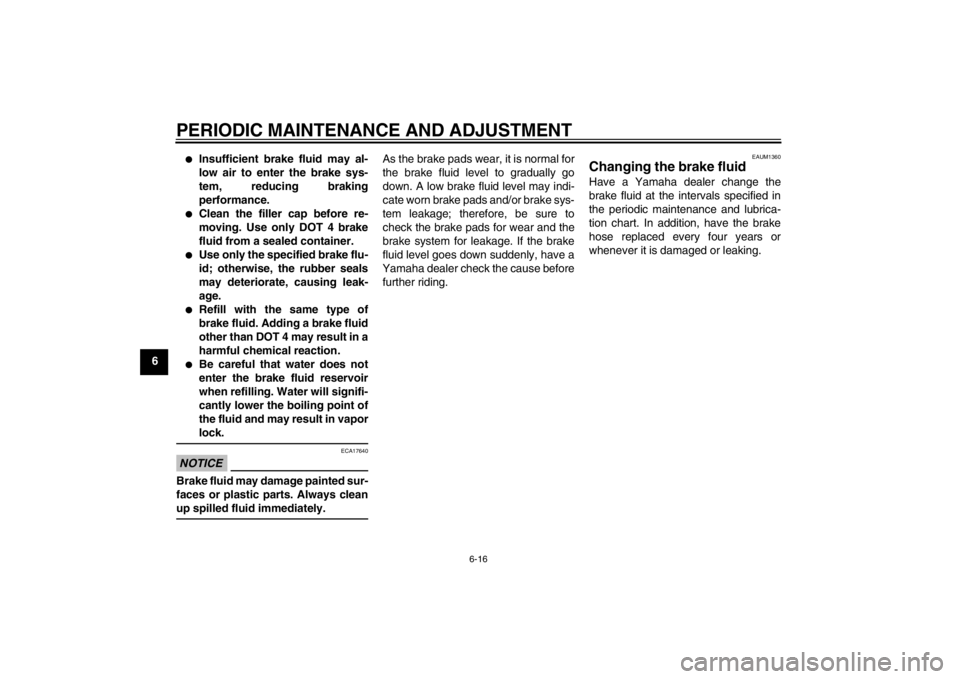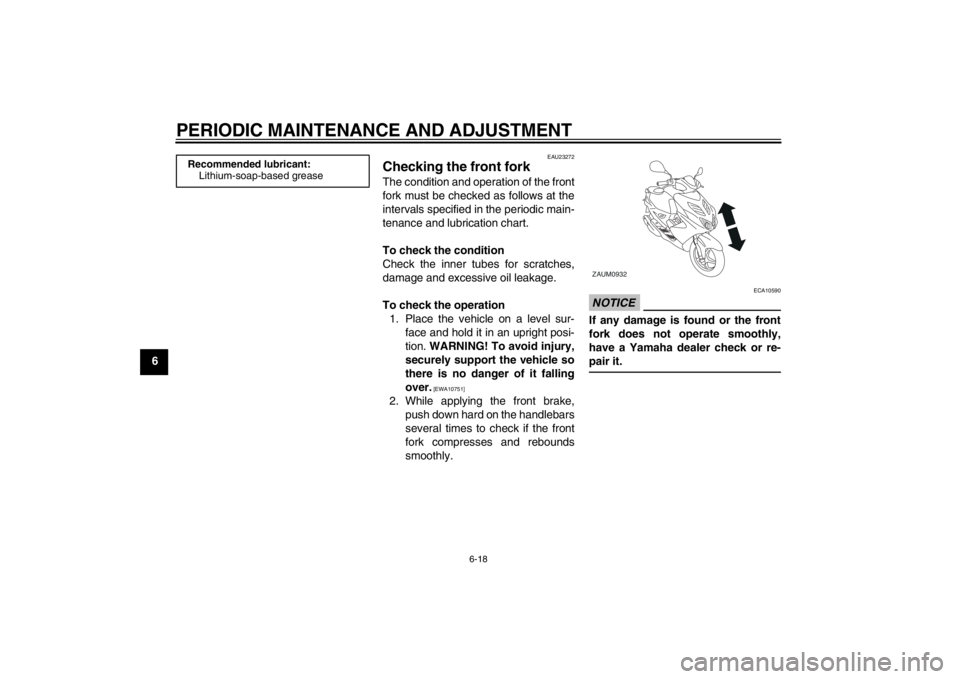2013 YAMAHA AEROX50 oil level
[x] Cancel search: oil levelPage 6 of 74

TABLE OF CONTENTSSAFETY INFORMATION ..................1-1
Further safe-riding points ................1-5
DESCRIPTION ..................................2-1
Left view ..........................................2-1
Right view ........................................2-2
Controls and instruments.................2-3
INSTRUMENT AND CONTROL
FUNCTIONS.......................................3-1
Main switch/steering lock ................3-1
Indicator lights and warning light ....3-2
Speedometer unit (NS50N) .............3-3
Multi-function display (NS50)...........3-4
Handlebar switches ........................3-6
Front brake lever ............................3-7
Rear brake lever .............................3-7
Fuel and 2-stroke engine oil tank
caps .............................................3-8
Fuel .................................................3-9
Catalytic converter ........................3-10
2-stroke engine oil ........................3-10
Kickstarter .....................................3-11
Seats ............................................3-11
Storage compartment ...................3-12
Adjusting the shock absorber
assembly (if equipped) ...............3-13FOR YOUR SAFETY –
PRE-OPERATION CHECKS............. 4-1
OPERATION AND IMPORTANT
RIDING POINTS................................. 5-1
Starting a cold engine .................... 5-1
Starting off ...................................... 5-2
Acceleration and deceleration ........ 5-2
Braking ........................................... 5-2
Tips for reducing fuel
consumption ............................... 5-3
Engine break-in .............................. 5-3
Parking ........................................... 5-4
PERIODIC MAINTENANCE AND
ADJUSTMENT................................... 6-1
Periodic maintenance chart for
the emission control system ....... 6-2
General maintenance and
lubrication chart .......................... 6-3
Removing and installing the cowling
and panel .................................... 6-6
Checking the spark plug ................. 6-7
Final transmission oil ...................... 6-8
Coolant ........................................... 6-9
Cleaning the air filter element ...... 6-10
Adjusting the carburetor ............... 6-11
Checking the throttle grip free
play ........................................... 6-11
Tires ............................................. 6-12
Cast wheels .................................. 6-14Checking the front and rear brake
lever free play ........................... 6-14
Checking the front and rear brake
pads .......................................... 6-15
Checking the brake fluid level ...... 6-15
Changing the brake fluid .............. 6-16
Checking and lubricating
the throttle grip and cable ......... 6-17
Lubricating the front and rear
brake levers .............................. 6-17
Checking and lubricating the
centerstand ............................... 6-17
Checking the front fork ................. 6-18
Checking the steering .................. 6-19
Checking the wheel bearings ....... 6-19
Battery ......................................... 6-19
Replacing the fuse ....................... 6-21
Replacing the headlight bulb ....... 6-22
Replacing the tail/brake light
bulb ........................................... 6-23
Replacing a turn signal light
bulb ........................................... 6-23
License plate light ........................ 6-24
Replacing the auxiliary light bulb
(if equipped) .............................. 6-24
Troubleshooting ........................... 6-25
Troubleshooting charts ................ 6-26
SCOOTER CARE AND STORAGE... 7-1
Matte color caution ........................ 7-1
Care ............................................... 7-1U1PHE0E0.book Page 1 Wednesday, August 29, 2012 4:42 PM
Page 18 of 74

INSTRUMENT AND CONTROL FUNCTIONS
3-2
3To unlock the steering
Push the key in, and then turn it to “ ”
while still pushing it.
EAU11006
Indicator lights and warning
light NS50
NS50N
EAU11020
Turn signal indicator light “ ”
This indicator light flashes when the
turn signal switch is pushed to the left or
right.
EAU11080
High beam indicator light “ ”
This indicator light comes on when the
high beam of the headlight is switched
on.
EAUM2771
Oil level warning light “ ”
This warning light comes on if the oil
level in the 2-stroke engine oil tank is
low during operation. If the warning
light comes on during operation, stop
immediately and fill the oil tank with Ya-
malube 2 or equivalent 2-stroke engine
oil of either JASO grade “FC” or ISO
grades “EG-C” or “EG-D”. The warning
light should go off after the 2-stroke en-
gine oil tank has been refilled.
The electrical circuit of the warning light
can be checked by turning the key
to “ ”. The warning light should come
on for a few seconds, and then go off.
1. Push.
2. Turn.
1. Coolant temperature warning light “ ”
2. High beam indicator light “ ”
3. Turn signal indicator light “ ”
4. Fuel level warning light “ ”
5. Oil level warning light “ ”ZAUM0908
12
3
4
5
ZAUM0957
3
45
2
1
U1PHE0E0.book Page 2 Wednesday, August 29, 2012 4:42 PM
Page 19 of 74

INSTRUMENT AND CONTROL FUNCTIONS
3-3
3
TIPIf the warning light does not come on
when the key is in the “ ” position or
does not go off after the 2-stroke en-
gine oil tank has been refilled, have a
Yamaha dealer check the electrical cir-
cuit.NOTICE
ECA16291
Do not operate the vehicle until you
know that the engine oil level is suf-
ficient.
EAUM2791
Fuel level warning light “ ”
This warning light comes on when the
fuel level drops below approximately
1.0 L (0.26 US gal, 0.22 Imp.gal). When
this occurs, refuel as soon as possible.
The electrical circuit of the warning light
can be checked by turning the key
to “ ”. The warning light should come
on for a few seconds, and then go off.
If the warning light does not come on
initially when the key is turned to “ ”,
or if the warning light remains on, have
a Yamaha dealer check the electrical
circuit.
EAUM2781
Coolant temperature warning
light “ ”
This warning light comes on if the en-
gine overheats. If this occurs, stop the
engine immediately and allow the en-
gine to cool.
The electrical circuit of the warning light
can be checked by turning the key
to “ ”. The warning light should come
on for a few seconds, and then go off.
If the warning light does not come on
initially when the key is turned to “ ”,
or if the warning light remains on, have
a Yamaha dealer check the electrical
circuit.NOTICE
ECA10021
Do not continue to operate the en-
gine if it is overheating.TIP●
For radiator-fan-equipped vehi-
cles, the radiator fan(s) automati-
cally switch on or off according to
the coolant temperature in the ra-
diator.
●
If the engine overheats, see page
6-27 for further instructions.
EAUM1590
Speedometer unit (NS50N)The speedometer unit is equipped with
a speedometer, an odometer and a fuel
meter. The speedometer shows riding
speed. The odometer shows the total
distance traveled. The fuel meter indi-
cates the amount of fuel in the fuel tank.
(See page 3-2 for an explanation of the
fuel level warning light.)1. Speedometer
2. Odometer
3. Fuel meterZAUM0910
1
2
3
U1PHE0E0.book Page 3 Wednesday, August 29, 2012 4:42 PM
Page 31 of 74

FOR YOUR SAFETY – PRE-OPERATION CHECKS
4-1
4
EAU15596
Inspect your vehicle each time you use it to make sure the vehicle is in safe operating condition. Always follow the inspection
and maintenance procedures and schedules described in the Owner’s Manual.
WARNING
EWA11151
Failure to inspect or maintain the vehicle properly increases the possibility of an accident or equipment damage.
Do not operate the vehicle if you find any problem. If a problem cannot be corrected by the procedures provided in
this manual, have the vehicle inspected by a Yamaha dealer.Before using this vehicle, check the following points:
ITEM CHECKS PAGE
Fuel Check fuel level in fuel tank.
Refuel if necessary.
Check fuel line for leakage.3-9
2-stroke engine oil Check oil level in oil tank.
If necessary, add recommended oil to specified level.
Check vehicle for oil leakage.3-10
Final transmission oil Check vehicle for oil leakage. 6-8
Coolant Check coolant level in reservoir.
If necessary, add recommended coolant to specified level.
Check cooling system for leakage.6-9
Front brake Check operation.
If soft or spongy, have Yamaha dealer bleed hydraulic system.
Check brake pads for wear.
Replace if necessary.
Check fluid level in reservoir.
If necessary, add specified brake fluid to specified level.
Check hydraulic system for leakage.6-14, 6-15, 6-15
U1PHE0E0.book Page 1 Wednesday, August 29, 2012 4:42 PM
Page 40 of 74

PERIODIC MAINTENANCE AND ADJUSTMENT
6-4
6
9*Wheel bearings • Check bearing for looseness or
damage. √√√√
10 *Steering bearings Check bearing play and steering
for roughness. √√√√√
Lubricate with lithium-soap-based grease. Every 24000 km (14000 mi)
11 *Chassis fasteners Make sure that all nuts, bolts and
screws are properly tightened. √√√√√
12 Front brake lever
pivot shaft
Lubricate with silicone grease.
√√√√√
13 Rear brake lever
pivot shaft Lubricate with silicone grease.
√√√√√
14 Centerstand Check operation.
Lubricate. √√√√√
15 *Front fork Check operation and for oil leak-
age. √√√√
16 *Shock absorber as-
sembly Check operation and shock ab-
sorber for oil leakage. √√√√
17 *Autolube pump Check operation.
Bleed if necessary. √√√√
18 *Cooling system Check coolant level and vehicle
for coolant leakage. √√√√√
Change coolant. Every 3 years
19 Final transmission
oil Check vehicle for oil leakage.
√√ √
Change. √√√
20 *V- b e l t Replace. Every 10000 km (6000 mi)
NO. ITEM CHECK OR MAINTENANCE JOB
ODOMETER READING
ANNUAL
CHECK
1000 km
(600 mi) 6000 km
(3500 mi) 12000 km
(7000 mi) 18000 km
(10500 mi) 24000 km
(14000 mi)
U1PHE0E0.book Page 4 Thursday, February 21, 2013 2:56 PM
Page 52 of 74

PERIODIC MAINTENANCE AND ADJUSTMENT
6-16
6
●
Insufficient brake fluid may al-
low air to enter the brake sys-
tem, reducing braking
performance.
●
Clean the filler cap before re-
moving. Use only DOT 4 brake
fluid from a sealed container.
●
Use only the specified brake flu-
id; otherwise, the rubber seals
may deteriorate, causing leak-
age.
●
Refill with the same type of
brake fluid. Adding a brake fluid
other than DOT 4 may result in a
harmful chemical reaction.
●
Be careful that water does not
enter the brake fluid reservoir
when refilling. Water will signifi-
cantly lower the boiling point of
the fluid and may result in vapor
lock.
NOTICE
ECA17640
Brake fluid may damage painted sur-
faces or plastic parts. Always clean
up spilled fluid immediately.
As the brake pads wear, it is normal for
the brake fluid level to gradually go
down. A low brake fluid level may indi-
cate worn brake pads and/or brake sys-
tem leakage; therefore, be sure to
check the brake pads for wear and the
brake system for leakage. If the brake
fluid level goes down suddenly, have a
Yamaha dealer check the cause before
further riding.
EAUM1360
Changing the brake fluid Have a Yamaha dealer change the
brake fluid at the intervals specified in
the periodic maintenance and lubrica-
tion chart. In addition, have the brake
hose replaced every four years or
whenever it is damaged or leaking.
U1PHE0E0.book Page 16 Wednesday, August 29, 2012 4:42 PM
Page 54 of 74

PERIODIC MAINTENANCE AND ADJUSTMENT
6-18
6
EAU23272
Checking the front fork The condition and operation of the front
fork must be checked as follows at the
intervals specified in the periodic main-
tenance and lubrication chart.
To check the condition
Check the inner tubes for scratches,
damage and excessive oil leakage.
To check the operation
1. Place the vehicle on a level sur-
face and hold it in an upright posi-
tion. WARNING! To avoid injury,
securely support the vehicle so
there is no danger of it falling
over.
[EWA10751]
2. While applying the front brake,
push down hard on the handlebars
several times to check if the front
fork compresses and rebounds
smoothly.
NOTICE
ECA10590
If any damage is found or the front
fork does not operate smoothly,
have a Yamaha dealer check or re-
pair it.
Recommended lubricant:
Lithium-soap-based grease
ZAUM0932
U1PHE0E0.book Page 18 Wednesday, August 29, 2012 4:42 PM
Page 68 of 74

SPECIFICATIONS
8-1
8
Dimensions:Overall length:
1870 mm (73.6 in)
Overall width:
NS50 700 mm (27.6 in)
NS50N 725 mm (28.5 in)
Overall height:
NS50 1155 mm (45.5 in)
NS50N 1115 mm (43.9 in)
Seat height:
815/930 mm (32.1/36.6 in)
Wheelbase:
1275 mm (50.2 in)
Ground clearance:
130 mm (5.12 in)
Minimum turning radius:
2000 mm (78.7 in)Weight:Curb weight:
97 kg (214 lb)Engine:Engine type:
Liquid cooled 2-stroke
Cylinder arrangement:
Single cylinder
Displacement:
49 cm³
Bore × stroke:
40.0 × 39.2 mm (1.57 × 1.54 in)
Compression ratio:
11.50–12.50 : 1
Starting system:
Electric starter and kickstarterLubrication system:
Separate lubrication (Yamaha autolube)
Engine oil:Type:
YAMALUBE 2S or 2-stroke engine oil
(JASO FC grade) or (ISO EG-C or EG-D
grade)
Engine oil quantity:
Quantity:
1.40 L (1.48 US qt, 1.23 Imp.qt)Final transmission oil:Type:
SAE 10W-30 type SE motor oil
Quantity:
0.11 L (0.12 US qt, 0.10 Imp.qt)Cooling system:Coolant reservoir capacity (up to the
maximum level mark):
0.25 L (0.26 US qt, 0.22 Imp.qt)
Radiator capacity (including all routes):
1.20 L (1.27 US qt, 1.06 Imp.qt)Air filter:Air filter element:
Wet elementFuel:Recommended fuel:
Premium unleaded gasoline only
Fuel tank capacity:
7.0 L (1.85 US gal, 1.54 Imp.gal)
Fuel reserve amount:
1.0 L (0.26 US gal, 0.22 Imp.gal)Carburetor:Type × quantity:
PHVA 12 ZS x 1
Spark plug(s):Manufacturer/model:
NGK/BR8HS
Spark plug gap:
0.6–0.7 mm (0.024–0.028 in)Clutch:Clutch type:
Dry, centrifugal automaticTransmission:Primary reduction ratio:
1
Final drive:
Gear
Secondary reduction ratio:
52/13 × 43/14 (12.286)
Transmission type:
V-belt automatic
Operation:
Centrifugal automatic typeChassis:Frame type:
Underbone
Caster angle:
27.00 °
Trail:
87 mm (3.4 in)Front tire:Type:
Tubeless
Size:
120/70-13 53P(Michelin)
53L(SAVA,Metzeler)
Manufacturer/model:
MICHELIN/POWER PURE SC
U1PHE0E0.book Page 1 Wednesday, August 29, 2012 4:42 PM